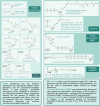Sequencing and Optical Genome Mapping for the Adventurous Chemist
- PMID: 39735829
- PMCID: PMC11673194
- DOI: 10.1021/cbmi.4c00060
Sequencing and Optical Genome Mapping for the Adventurous Chemist
Abstract
This review provides a comprehensive overview of the chemistries and workflows of the sequencing methods that have been or are currently commercially available, providing a very brief historical introduction to each method. The main optical genome mapping approaches are introduced in the same manner, although only a subset of these are or have ever been commercially available. The review comes with a deck of slides containing all of the figures for ease of access and consultation.
© 2024 The Authors. Co-published by Nanjing University and American Chemical Society.
Conflict of interest statement
The authors declare the following competing financial interest(s): Johan Hofkens and Volker Leen are co-founders of Perseus Biomics.
Figures




















Similar articles
-
Multiplex structural variant detection by whole-genome mapping and nanopore sequencing.Sci Rep. 2022 Apr 20;12(1):6512. doi: 10.1038/s41598-022-10483-7. Sci Rep. 2022. PMID: 35444207 Free PMC article.
-
diArk 2.0 provides detailed analyses of the ever increasing eukaryotic genome sequencing data.BMC Res Notes. 2011 Sep 9;4:338. doi: 10.1186/1756-0500-4-338. BMC Res Notes. 2011. PMID: 21906294 Free PMC article.
-
Optical mapping of DNA: single-molecule-based methods for mapping genomes.Biopolymers. 2011 May;95(5):298-311. doi: 10.1002/bip.21579. Epub 2011 Jan 4. Biopolymers. 2011. PMID: 21207457 Review.
-
Impact of microbiological molecular methodologies on adaptive sampling using nanopore sequencing in metagenomic studies.Environ Microbiome. 2025 May 5;20(1):47. doi: 10.1186/s40793-025-00704-7. Environ Microbiome. 2025. PMID: 40325409 Free PMC article.
-
The Most Frequently Used Sequencing Technologies and Assembly Methods in Different Time Segments of the Bacterial Surveillance and RefSeq Genome Databases.Front Cell Infect Microbiol. 2020 Oct 19;10:527102. doi: 10.3389/fcimb.2020.527102. eCollection 2020. Front Cell Infect Microbiol. 2020. PMID: 33194784 Free PMC article. Review.
References
-
- Alberts B.; et al.DNA Replication Mechanisms. Molecular Biology of the Cell, 4th ed.; Garland Science, 2002.
Publication types
LinkOut - more resources
Full Text Sources
Molecular Biology Databases
